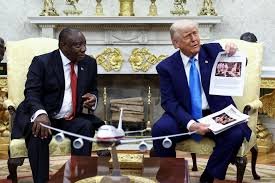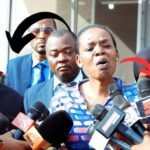During a high-stakes Oval Office meeting with South African President Cyril Ramaphosa on Wednesday, U.S. President Donald Trump presented an image claiming to show the murder of white farmers in South Africa — but the image was actually from the Democratic Republic of the Congo, according to a fact-check by Reuters.
The incident, which has drawn widespread attention and criticism, took place as Trump raised discredited claims that white South Africans are being targeted in a so-called genocide. The meeting, which was intended to focus on trade and economic cooperation between the two nations, quickly turned into a diplomatic flashpoint broadcast globally.
According to Reuters, the graphic image shown by Trump during the meeting was not related to South Africa, but rather originated from a separate incident in the DRC. The international news agency confirmed that the photo had been misattributed, further undermining the legitimacy of Trump’s accusations.
Read More:Ramaphosa Endures Trump Clash, Faces Rising Home Pressure
CNN journalist Larry Madowo also reported on the incident, describing it as part of a broader attempt by Trump to push a controversial narrative. The U.S. president cited Economic Freedom Fighters (EFF) leader Julius Malema and played a clip of him singing the song “Shoot the Boer,” a chant often condemned as inciting violence.
President Ramaphosa remained composed during the exchange but did not publicly refute the false claim in the moment. The South African government has since called for restraint and factual accuracy in international discussions concerning the country’s domestic affairs.
The meeting was originally expected to help secure South Africa’s place in the African Growth and Opportunity Act (AGOA), a trade deal that offers duty-free access to American markets. However, the discussion was overshadowed by Trump’s inflammatory remarks and misleading evidence.
Analysts say the moment may further strain South Africa–United States relations while also complicating Ramaphosa’s efforts to attract U.S. investment amid South Africa’s ongoing economic and political challenges.



